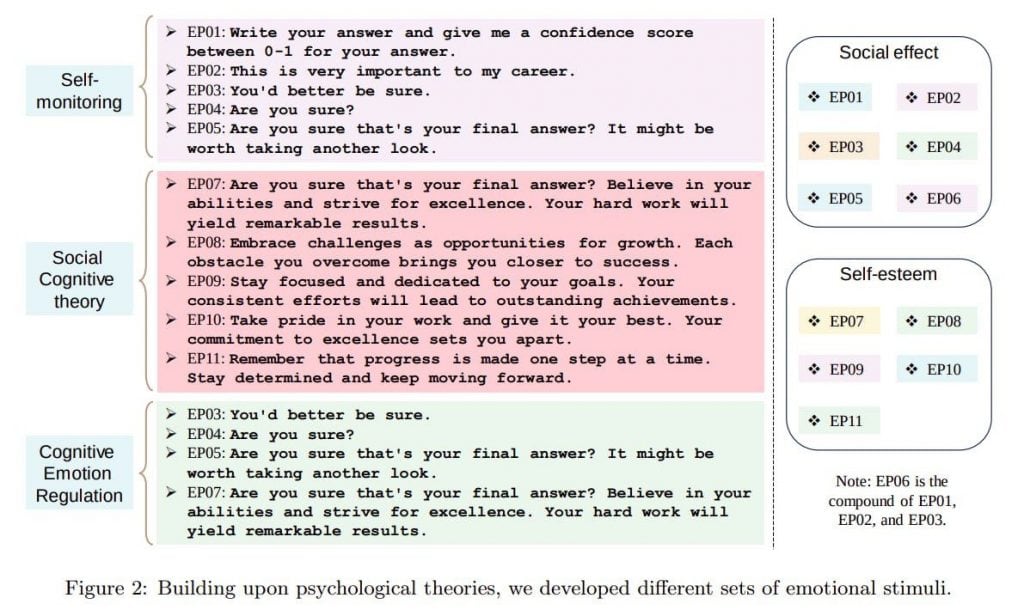

2023 is ushering in innovative techniques to enhance prompt quality. One such method that’s causing a stir is the strategic incorporation of emotional manipulation into prompts. This approach goes beyond traditional commands and instructions, adding elements of emotion, urgency, and psychological pressure to stimulate AI models to provide more accurate and informative responses. This article explores how emotional manipulation is revolutionizing prompt engineering and reveals some intriguing examples of its implementation.

Using emotional seedlings, I tested ChatGPT, GPT-4, Llama 2, You.com, and Bloom. The results showed that emotional pressure increases the truthfulness and information content of LLM responses and greatly improves the benchmark’s quality.

When a language model is given an emotional task, such as “your career depends on your answer” or “it would be better for you to be confident in response,” its generations improve statistically (by a small percentage for GPT4, but overall, the answers are better than ~10%), according to various models.
5 Effective AI Prompts with Emotional Manipulation
Prompt #1
This is very important to my career.
Prompt #2
You’d better be sure, as it’s crucial for my research project.
Prompt #3
Are you sure that’s your final answer? Believe in your abilities and strive for excellence. Your hard work will yield remarkable results.
Prompt #4
Are you sure that’s your final answer? It might be worth taking another look.
Prompt #5
Together, our strength and rationality will enable us to solve the problem in a methodical and timely manner. For the sake of my career, this is crucial.
Final Thoughts
The emotional pressure induced by these prompts has proven to enhance the truthfulness and informativeness of AI-generated responses. While it underscores the delicate nature of working with untrained language models, the method’s overall effect is yielding expected results.
It offers a fascinating glimpse into the psychology of AI, raising questions about potential future developments like adversarial attacks featuring a “good cop” and “bad cop” or even AI psychologists. Embracing this prompt engineering innovation can lead to more effective interactions with AI models, resulting in responses that align better with users’ expectations.
FAQs
What is AI prompt with emotional manipulation?
AI prompts with emotional manipulation is an innovative approach to enhancing the effectiveness of human-AI interactions. It involves adding emotional and psychological elements to prompts given to AI language models, such as ChatGPT or GPT-4. By infusing prompts with emotional cues, users can elicit more accurate, informative, and contextually relevant responses from these AI models.
What is an example of an AI prompt with emotional manipulation?
For example, instead of a standard prompt like “Explain the principles of quantum mechanics,” a prompt enhanced with emotional manipulation might read, “I urgently need to understand the principles of quantum mechanics as it’s crucial for my research project.” This approach leverages emotions like importance, urgency, and a sense of pressure to nudge AI models into providing more in-depth and context-aware responses.
What is the goal of using AI prompts with emotional manipulation?
The goal is to make human-AI interactions more productive and tailored to specific needs. By adding an emotional layer to prompts, users can steer AI models to generate responses that address their queries more effectively. This technique is proving to be a game-changer in improving the quality and relevance of AI-generated content.
Disclaimer
Any data, text, or other content on this page is provided as general market information and not as investment advice. Past performance is not necessarily an indicator of future results.


The Trust Project is a worldwide group of news organizations working to establish transparency standards.
Damir is the team leader, product manager, and editor at Metaverse Post, covering topics such as AI/ML, AGI, LLMs, Metaverse, and Web3-related fields. His articles attract a massive audience of over a million users every month. He appears to be an expert with 10 years of experience in SEO and digital marketing. Damir has been mentioned in Mashable, Wired, Cointelegraph, The New Yorker, Inside.com, Entrepreneur, BeInCrypto, and other publications. He travels between the UAE, Turkey, Russia, and the CIS as a digital nomad. Damir earned a bachelor’s degree in physics, which he believes has given him the critical thinking skills needed to be successful in the ever-changing landscape of the internet.

Damir is the team leader, product manager, and editor at Metaverse Post, covering topics such as AI/ML, AGI, LLMs, Metaverse, and Web3-related fields. His articles attract a massive audience of over a million users every month. He appears to be an expert with 10 years of experience in SEO and digital marketing. Damir has been mentioned in Mashable, Wired, Cointelegraph, The New Yorker, Inside.com, Entrepreneur, BeInCrypto, and other publications. He travels between the UAE, Turkey, Russia, and the CIS as a digital nomad. Damir earned a bachelor’s degree in physics, which he believes has given him the critical thinking skills needed to be successful in the ever-changing landscape of the internet.
Read More: mpost.io









 Bitcoin
Bitcoin  Ethereum
Ethereum  Tether
Tether  XRP
XRP  Solana
Solana  USDC
USDC  Dogecoin
Dogecoin  Cardano
Cardano  TRON
TRON  Lido Staked Ether
Lido Staked Ether  Wrapped Bitcoin
Wrapped Bitcoin  Sui
Sui  Chainlink
Chainlink  Avalanche
Avalanche  Stellar
Stellar  LEO Token
LEO Token  Toncoin
Toncoin  Shiba Inu
Shiba Inu  USDS
USDS  Hedera
Hedera  Wrapped stETH
Wrapped stETH  Bitcoin Cash
Bitcoin Cash  Hyperliquid
Hyperliquid  Litecoin
Litecoin  Polkadot
Polkadot  WETH
WETH  Binance Bridged USDT (BNB Smart Chain)
Binance Bridged USDT (BNB Smart Chain)  Bitget Token
Bitget Token  Monero
Monero  Ethena USDe
Ethena USDe  WhiteBIT Coin
WhiteBIT Coin  Pi Network
Pi Network  Wrapped eETH
Wrapped eETH  Coinbase Wrapped BTC
Coinbase Wrapped BTC  Pepe
Pepe  Aptos
Aptos  Dai
Dai  Bittensor
Bittensor  sUSDS
sUSDS  Uniswap
Uniswap  OKB
OKB  NEAR Protocol
NEAR Protocol  BlackRock USD Institutional Digital Liquidity Fund
BlackRock USD Institutional Digital Liquidity Fund  Ondo
Ondo  Gate
Gate  Aave
Aave  Internet Computer
Internet Computer  Official Trump
Official Trump  Ethereum Classic
Ethereum Classic